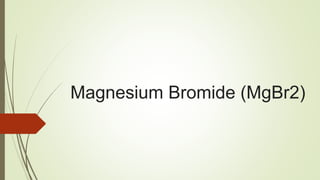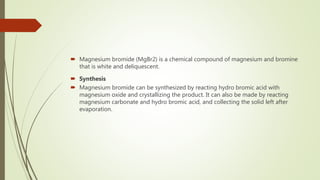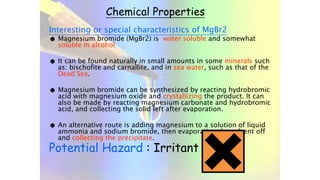Magnesium bromide (MgBr2) is a white, hygroscopic chemical compound of magnesium and bromine. It readily absorbs moisture from the air due to its hygroscopic nature. MgBr2 can be synthesized by reacting hydrobromic acid with magnesium oxide and crystallizing the product. When dissolved in water, MgBr2 dissociates into magnesium ions (Mg2+) and bromide ions (Br-). MgBr2 is commonly used as a drying agent due to its ability to absorb water. Other hygroscopic salts like calcium chloride and calcium sulfate are also widely used as desiccants.






![Physical Properties
Melting point : 711°C
Boiling point : 1158°C
Physical state at room temperature: crystalline
solid
Colour : white
Density : 3.72g/cm³
Solubility in water : 102g/100mL
Electrical conductivity : poor in solid , good in
liquid
[ ]Br
x
X
[ ]Mg Br[ ]
X
XX
X
X
X
X
X
X
Ionic
Compound](https://image.slidesharecdn.com/magnesiumbromide-180306053836/85/Magnesium-bromide-7-320.jpg)
















